Motivation Theories: Strategies for Inspiring Employee Performance
VerifiedAdded on 2022/10/17
|9
|2094
|19
Report
AI Summary
This report explores various motivation theories applicable to leadership and management, focusing on how to inspire employees to achieve their best performance. It begins by presenting a real-world scenario where a content management team leader, Lewis, must motivate his team amidst staff changes and increasing workloads. The report then provides a concise overview of key motivation theories, including intrinsic and extrinsic motivation, Vroom’s Expectancy theory, Value-Percept theory, Maslow’s Hierarchy of Needs, Herzberg’s Two-Factor Theory, and McClelland’s Acquired Needs Theory. Each theory is explained with its implications for managing and motivating employees, addressing potential conflicts, and improving overall team performance. The report emphasizes the importance of understanding and applying these theories to create a balanced workforce and a positive work environment. Finally, it highlights the need for risk analysis to identify and address demotivating factors, ensuring a disciplined approach to achieving project success.
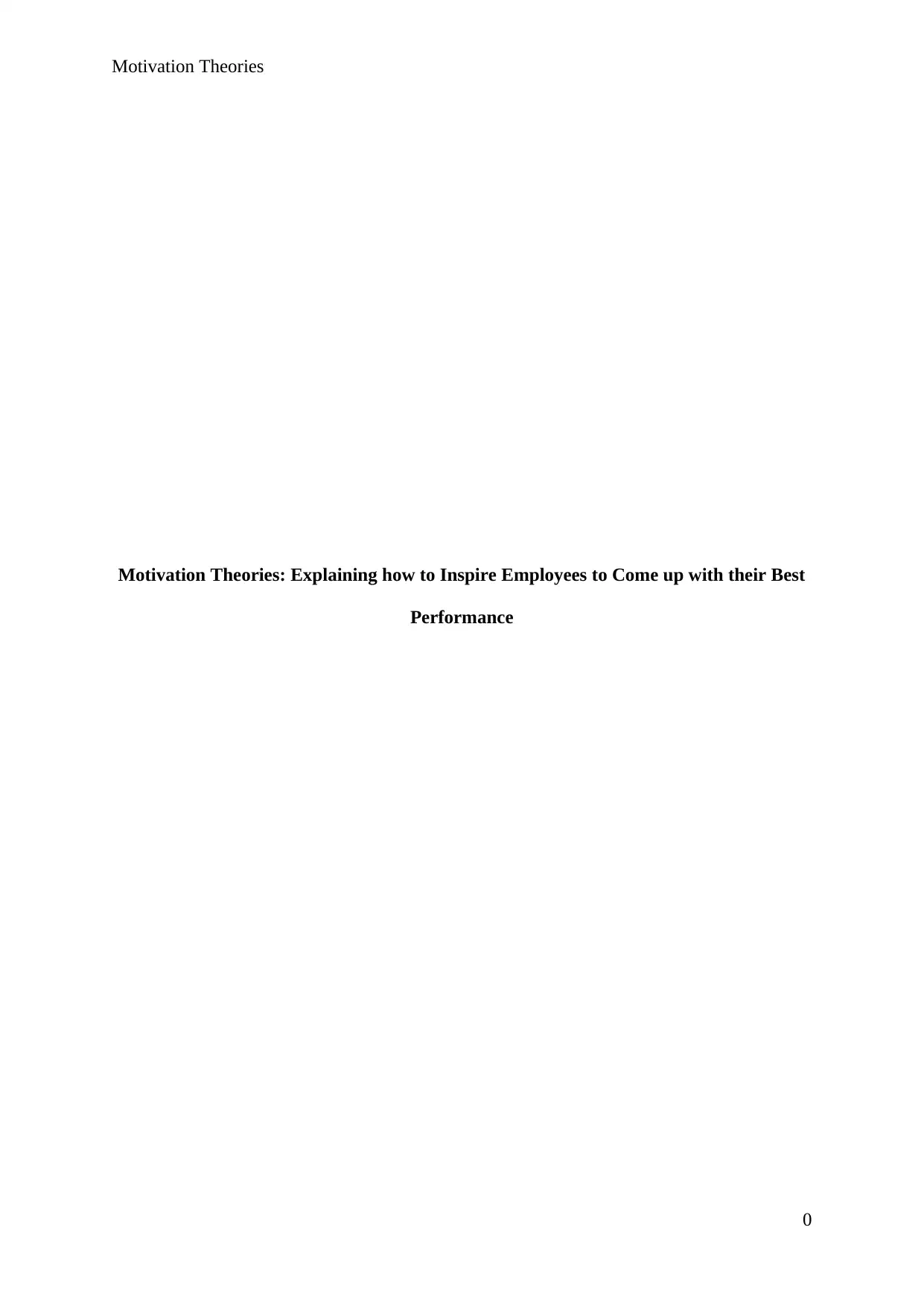
Motivation Theories
Motivation Theories: Explaining how to Inspire Employees to Come up with their Best
Performance
0
Motivation Theories: Explaining how to Inspire Employees to Come up with their Best
Performance
0
Paraphrase This Document
Need a fresh take? Get an instant paraphrase of this document with our AI Paraphraser
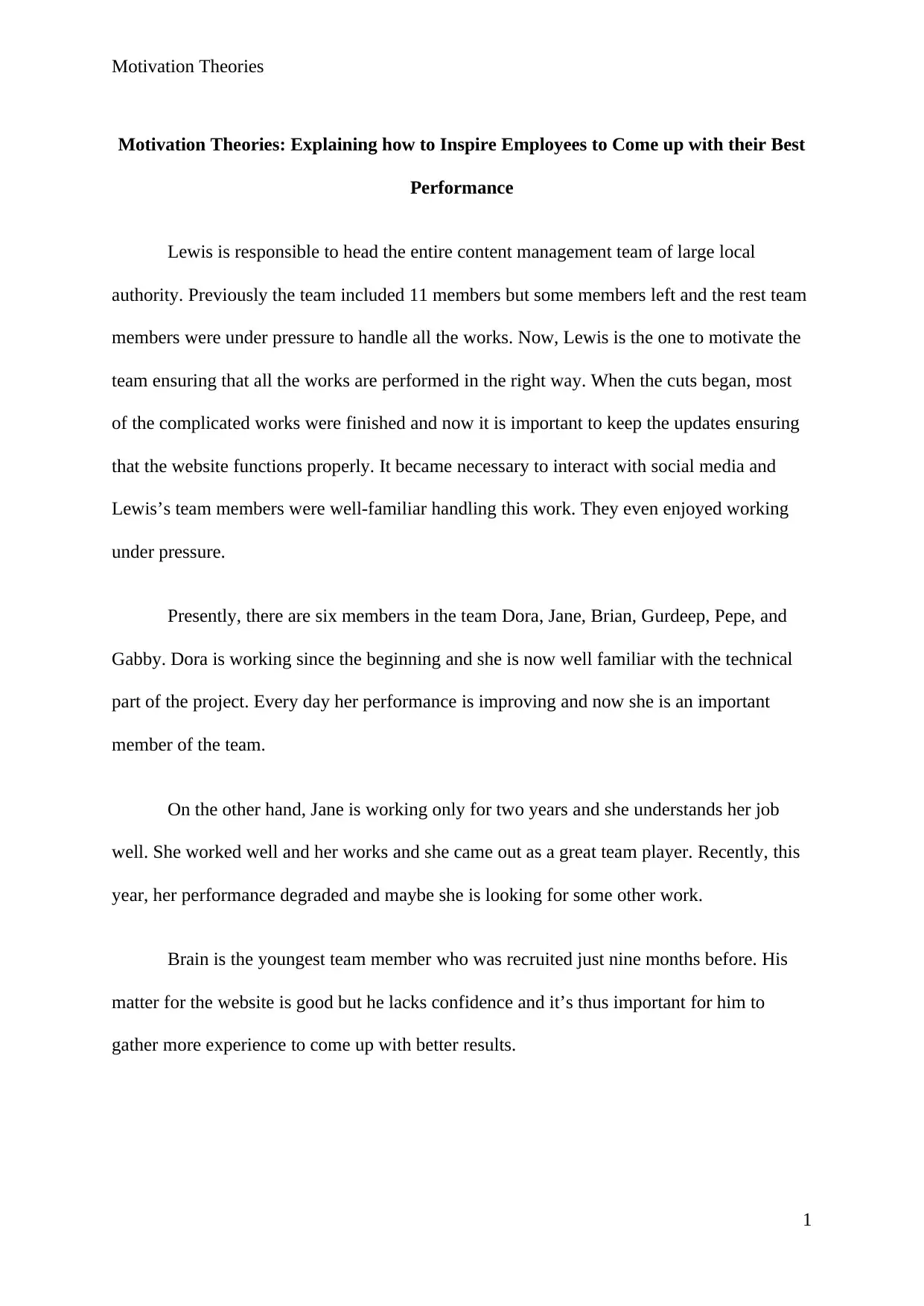
Motivation Theories
Motivation Theories: Explaining how to Inspire Employees to Come up with their Best
Performance
Lewis is responsible to head the entire content management team of large local
authority. Previously the team included 11 members but some members left and the rest team
members were under pressure to handle all the works. Now, Lewis is the one to motivate the
team ensuring that all the works are performed in the right way. When the cuts began, most
of the complicated works were finished and now it is important to keep the updates ensuring
that the website functions properly. It became necessary to interact with social media and
Lewis’s team members were well-familiar handling this work. They even enjoyed working
under pressure.
Presently, there are six members in the team Dora, Jane, Brian, Gurdeep, Pepe, and
Gabby. Dora is working since the beginning and she is now well familiar with the technical
part of the project. Every day her performance is improving and now she is an important
member of the team.
On the other hand, Jane is working only for two years and she understands her job
well. She worked well and her works and she came out as a great team player. Recently, this
year, her performance degraded and maybe she is looking for some other work.
Brain is the youngest team member who was recruited just nine months before. His
matter for the website is good but he lacks confidence and it’s thus important for him to
gather more experience to come up with better results.
1
Motivation Theories: Explaining how to Inspire Employees to Come up with their Best
Performance
Lewis is responsible to head the entire content management team of large local
authority. Previously the team included 11 members but some members left and the rest team
members were under pressure to handle all the works. Now, Lewis is the one to motivate the
team ensuring that all the works are performed in the right way. When the cuts began, most
of the complicated works were finished and now it is important to keep the updates ensuring
that the website functions properly. It became necessary to interact with social media and
Lewis’s team members were well-familiar handling this work. They even enjoyed working
under pressure.
Presently, there are six members in the team Dora, Jane, Brian, Gurdeep, Pepe, and
Gabby. Dora is working since the beginning and she is now well familiar with the technical
part of the project. Every day her performance is improving and now she is an important
member of the team.
On the other hand, Jane is working only for two years and she understands her job
well. She worked well and her works and she came out as a great team player. Recently, this
year, her performance degraded and maybe she is looking for some other work.
Brain is the youngest team member who was recruited just nine months before. His
matter for the website is good but he lacks confidence and it’s thus important for him to
gather more experience to come up with better results.
1
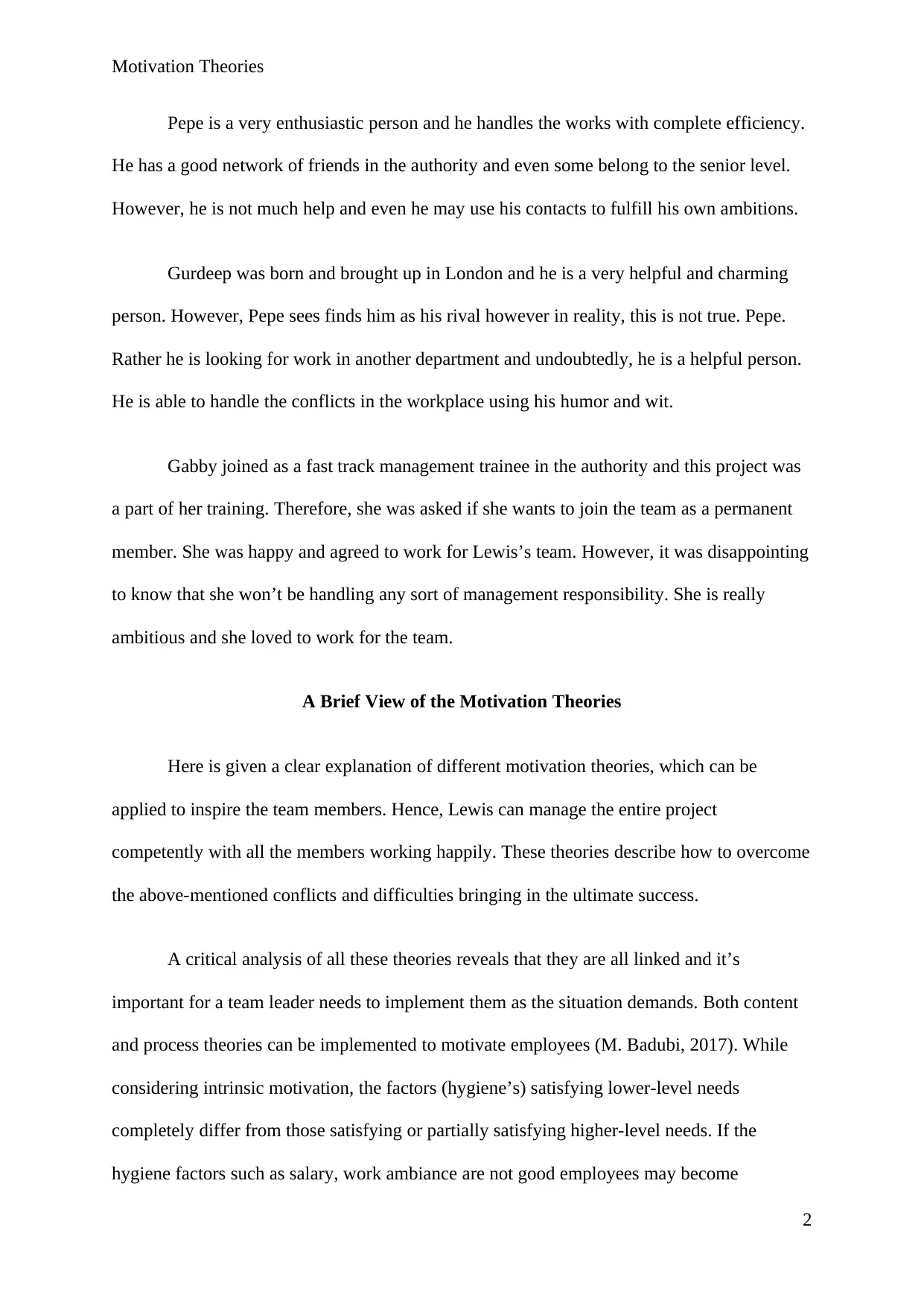
Motivation Theories
Pepe is a very enthusiastic person and he handles the works with complete efficiency.
He has a good network of friends in the authority and even some belong to the senior level.
However, he is not much help and even he may use his contacts to fulfill his own ambitions.
Gurdeep was born and brought up in London and he is a very helpful and charming
person. However, Pepe sees finds him as his rival however in reality, this is not true. Pepe.
Rather he is looking for work in another department and undoubtedly, he is a helpful person.
He is able to handle the conflicts in the workplace using his humor and wit.
Gabby joined as a fast track management trainee in the authority and this project was
a part of her training. Therefore, she was asked if she wants to join the team as a permanent
member. She was happy and agreed to work for Lewis’s team. However, it was disappointing
to know that she won’t be handling any sort of management responsibility. She is really
ambitious and she loved to work for the team.
A Brief View of the Motivation Theories
Here is given a clear explanation of different motivation theories, which can be
applied to inspire the team members. Hence, Lewis can manage the entire project
competently with all the members working happily. These theories describe how to overcome
the above-mentioned conflicts and difficulties bringing in the ultimate success.
A critical analysis of all these theories reveals that they are all linked and it’s
important for a team leader needs to implement them as the situation demands. Both content
and process theories can be implemented to motivate employees (M. Badubi, 2017). While
considering intrinsic motivation, the factors (hygiene’s) satisfying lower-level needs
completely differ from those satisfying or partially satisfying higher-level needs. If the
hygiene factors such as salary, work ambiance are not good employees may become
2
Pepe is a very enthusiastic person and he handles the works with complete efficiency.
He has a good network of friends in the authority and even some belong to the senior level.
However, he is not much help and even he may use his contacts to fulfill his own ambitions.
Gurdeep was born and brought up in London and he is a very helpful and charming
person. However, Pepe sees finds him as his rival however in reality, this is not true. Pepe.
Rather he is looking for work in another department and undoubtedly, he is a helpful person.
He is able to handle the conflicts in the workplace using his humor and wit.
Gabby joined as a fast track management trainee in the authority and this project was
a part of her training. Therefore, she was asked if she wants to join the team as a permanent
member. She was happy and agreed to work for Lewis’s team. However, it was disappointing
to know that she won’t be handling any sort of management responsibility. She is really
ambitious and she loved to work for the team.
A Brief View of the Motivation Theories
Here is given a clear explanation of different motivation theories, which can be
applied to inspire the team members. Hence, Lewis can manage the entire project
competently with all the members working happily. These theories describe how to overcome
the above-mentioned conflicts and difficulties bringing in the ultimate success.
A critical analysis of all these theories reveals that they are all linked and it’s
important for a team leader needs to implement them as the situation demands. Both content
and process theories can be implemented to motivate employees (M. Badubi, 2017). While
considering intrinsic motivation, the factors (hygiene’s) satisfying lower-level needs
completely differ from those satisfying or partially satisfying higher-level needs. If the
hygiene factors such as salary, work ambiance are not good employees may become
2
⊘ This is a preview!⊘
Do you want full access?
Subscribe today to unlock all pages.

Trusted by 1+ million students worldwide
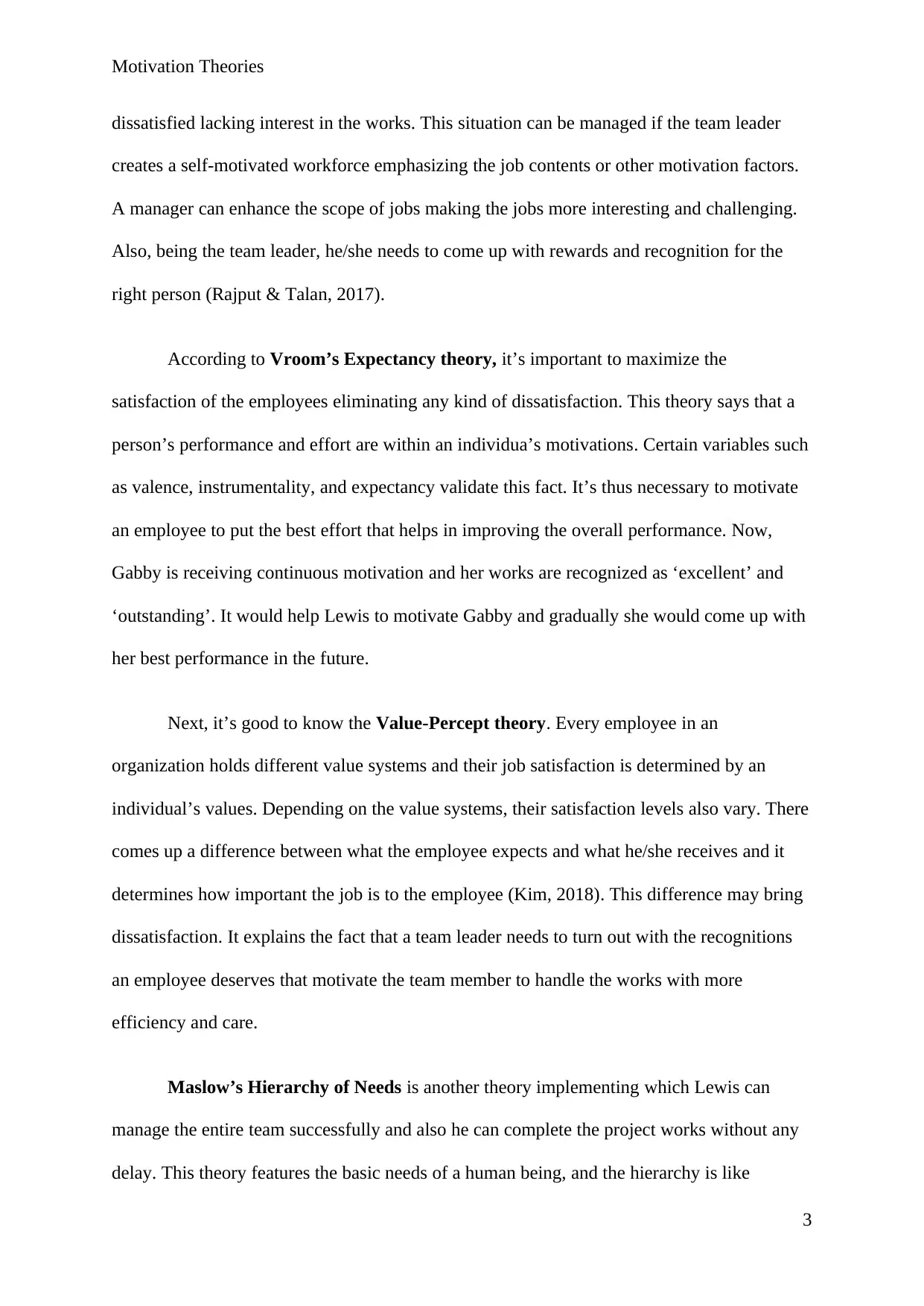
Motivation Theories
dissatisfied lacking interest in the works. This situation can be managed if the team leader
creates a self-motivated workforce emphasizing the job contents or other motivation factors.
A manager can enhance the scope of jobs making the jobs more interesting and challenging.
Also, being the team leader, he/she needs to come up with rewards and recognition for the
right person (Rajput & Talan, 2017).
According to Vroom’s Expectancy theory, it’s important to maximize the
satisfaction of the employees eliminating any kind of dissatisfaction. This theory says that a
person’s performance and effort are within an individua’s motivations. Certain variables such
as valence, instrumentality, and expectancy validate this fact. It’s thus necessary to motivate
an employee to put the best effort that helps in improving the overall performance. Now,
Gabby is receiving continuous motivation and her works are recognized as ‘excellent’ and
‘outstanding’. It would help Lewis to motivate Gabby and gradually she would come up with
her best performance in the future.
Next, it’s good to know the Value-Percept theory. Every employee in an
organization holds different value systems and their job satisfaction is determined by an
individual’s values. Depending on the value systems, their satisfaction levels also vary. There
comes up a difference between what the employee expects and what he/she receives and it
determines how important the job is to the employee (Kim, 2018). This difference may bring
dissatisfaction. It explains the fact that a team leader needs to turn out with the recognitions
an employee deserves that motivate the team member to handle the works with more
efficiency and care.
Maslow’s Hierarchy of Needs is another theory implementing which Lewis can
manage the entire team successfully and also he can complete the project works without any
delay. This theory features the basic needs of a human being, and the hierarchy is like
3
dissatisfied lacking interest in the works. This situation can be managed if the team leader
creates a self-motivated workforce emphasizing the job contents or other motivation factors.
A manager can enhance the scope of jobs making the jobs more interesting and challenging.
Also, being the team leader, he/she needs to come up with rewards and recognition for the
right person (Rajput & Talan, 2017).
According to Vroom’s Expectancy theory, it’s important to maximize the
satisfaction of the employees eliminating any kind of dissatisfaction. This theory says that a
person’s performance and effort are within an individua’s motivations. Certain variables such
as valence, instrumentality, and expectancy validate this fact. It’s thus necessary to motivate
an employee to put the best effort that helps in improving the overall performance. Now,
Gabby is receiving continuous motivation and her works are recognized as ‘excellent’ and
‘outstanding’. It would help Lewis to motivate Gabby and gradually she would come up with
her best performance in the future.
Next, it’s good to know the Value-Percept theory. Every employee in an
organization holds different value systems and their job satisfaction is determined by an
individual’s values. Depending on the value systems, their satisfaction levels also vary. There
comes up a difference between what the employee expects and what he/she receives and it
determines how important the job is to the employee (Kim, 2018). This difference may bring
dissatisfaction. It explains the fact that a team leader needs to turn out with the recognitions
an employee deserves that motivate the team member to handle the works with more
efficiency and care.
Maslow’s Hierarchy of Needs is another theory implementing which Lewis can
manage the entire team successfully and also he can complete the project works without any
delay. This theory features the basic needs of a human being, and the hierarchy is like
3
Paraphrase This Document
Need a fresh take? Get an instant paraphrase of this document with our AI Paraphraser
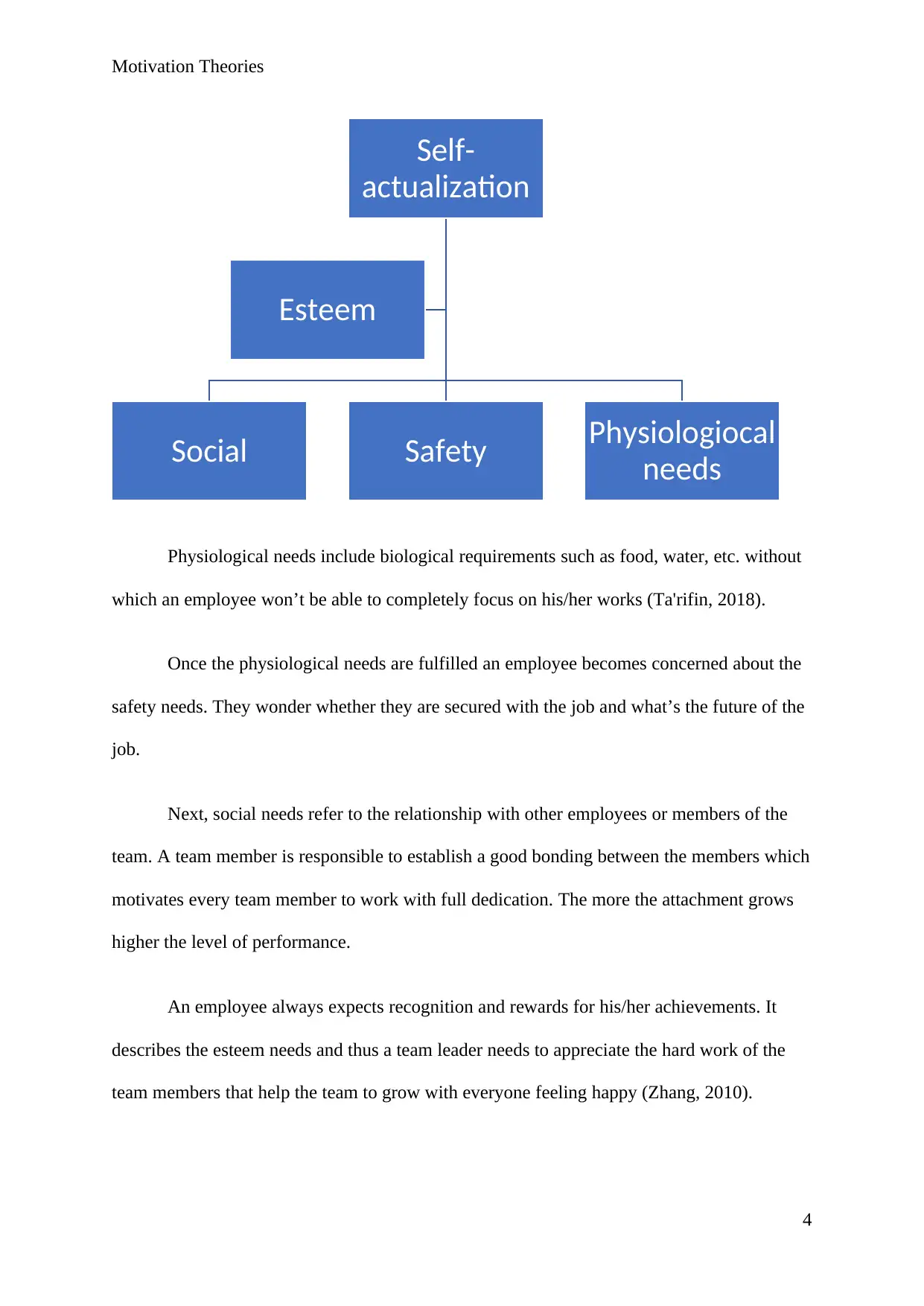
Motivation Theories
Physiological needs include biological requirements such as food, water, etc. without
which an employee won’t be able to completely focus on his/her works (Ta'rifin, 2018).
Once the physiological needs are fulfilled an employee becomes concerned about the
safety needs. They wonder whether they are secured with the job and what’s the future of the
job.
Next, social needs refer to the relationship with other employees or members of the
team. A team member is responsible to establish a good bonding between the members which
motivates every team member to work with full dedication. The more the attachment grows
higher the level of performance.
An employee always expects recognition and rewards for his/her achievements. It
describes the esteem needs and thus a team leader needs to appreciate the hard work of the
team members that help the team to grow with everyone feeling happy (Zhang, 2010).
4
Self-
actualization
Social Safety Physiologiocal
needs
Esteem
Physiological needs include biological requirements such as food, water, etc. without
which an employee won’t be able to completely focus on his/her works (Ta'rifin, 2018).
Once the physiological needs are fulfilled an employee becomes concerned about the
safety needs. They wonder whether they are secured with the job and what’s the future of the
job.
Next, social needs refer to the relationship with other employees or members of the
team. A team member is responsible to establish a good bonding between the members which
motivates every team member to work with full dedication. The more the attachment grows
higher the level of performance.
An employee always expects recognition and rewards for his/her achievements. It
describes the esteem needs and thus a team leader needs to appreciate the hard work of the
team members that help the team to grow with everyone feeling happy (Zhang, 2010).
4
Self-
actualization
Social Safety Physiologiocal
needs
Esteem
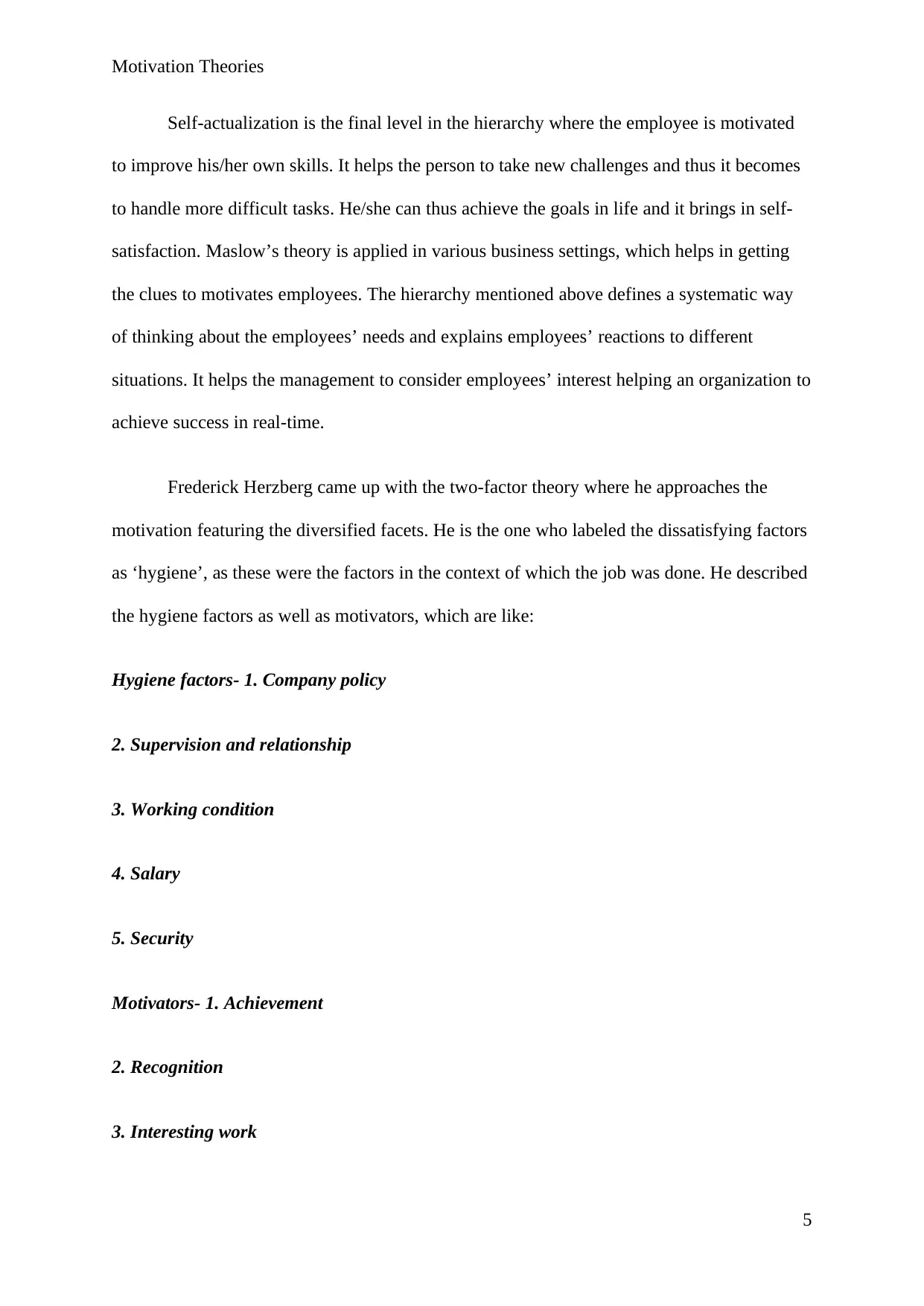
Motivation Theories
Self-actualization is the final level in the hierarchy where the employee is motivated
to improve his/her own skills. It helps the person to take new challenges and thus it becomes
to handle more difficult tasks. He/she can thus achieve the goals in life and it brings in self-
satisfaction. Maslow’s theory is applied in various business settings, which helps in getting
the clues to motivates employees. The hierarchy mentioned above defines a systematic way
of thinking about the employees’ needs and explains employees’ reactions to different
situations. It helps the management to consider employees’ interest helping an organization to
achieve success in real-time.
Frederick Herzberg came up with the two-factor theory where he approaches the
motivation featuring the diversified facets. He is the one who labeled the dissatisfying factors
as ‘hygiene’, as these were the factors in the context of which the job was done. He described
the hygiene factors as well as motivators, which are like:
Hygiene factors- 1. Company policy
2. Supervision and relationship
3. Working condition
4. Salary
5. Security
Motivators- 1. Achievement
2. Recognition
3. Interesting work
5
Self-actualization is the final level in the hierarchy where the employee is motivated
to improve his/her own skills. It helps the person to take new challenges and thus it becomes
to handle more difficult tasks. He/she can thus achieve the goals in life and it brings in self-
satisfaction. Maslow’s theory is applied in various business settings, which helps in getting
the clues to motivates employees. The hierarchy mentioned above defines a systematic way
of thinking about the employees’ needs and explains employees’ reactions to different
situations. It helps the management to consider employees’ interest helping an organization to
achieve success in real-time.
Frederick Herzberg came up with the two-factor theory where he approaches the
motivation featuring the diversified facets. He is the one who labeled the dissatisfying factors
as ‘hygiene’, as these were the factors in the context of which the job was done. He described
the hygiene factors as well as motivators, which are like:
Hygiene factors- 1. Company policy
2. Supervision and relationship
3. Working condition
4. Salary
5. Security
Motivators- 1. Achievement
2. Recognition
3. Interesting work
5
⊘ This is a preview!⊘
Do you want full access?
Subscribe today to unlock all pages.

Trusted by 1+ million students worldwide
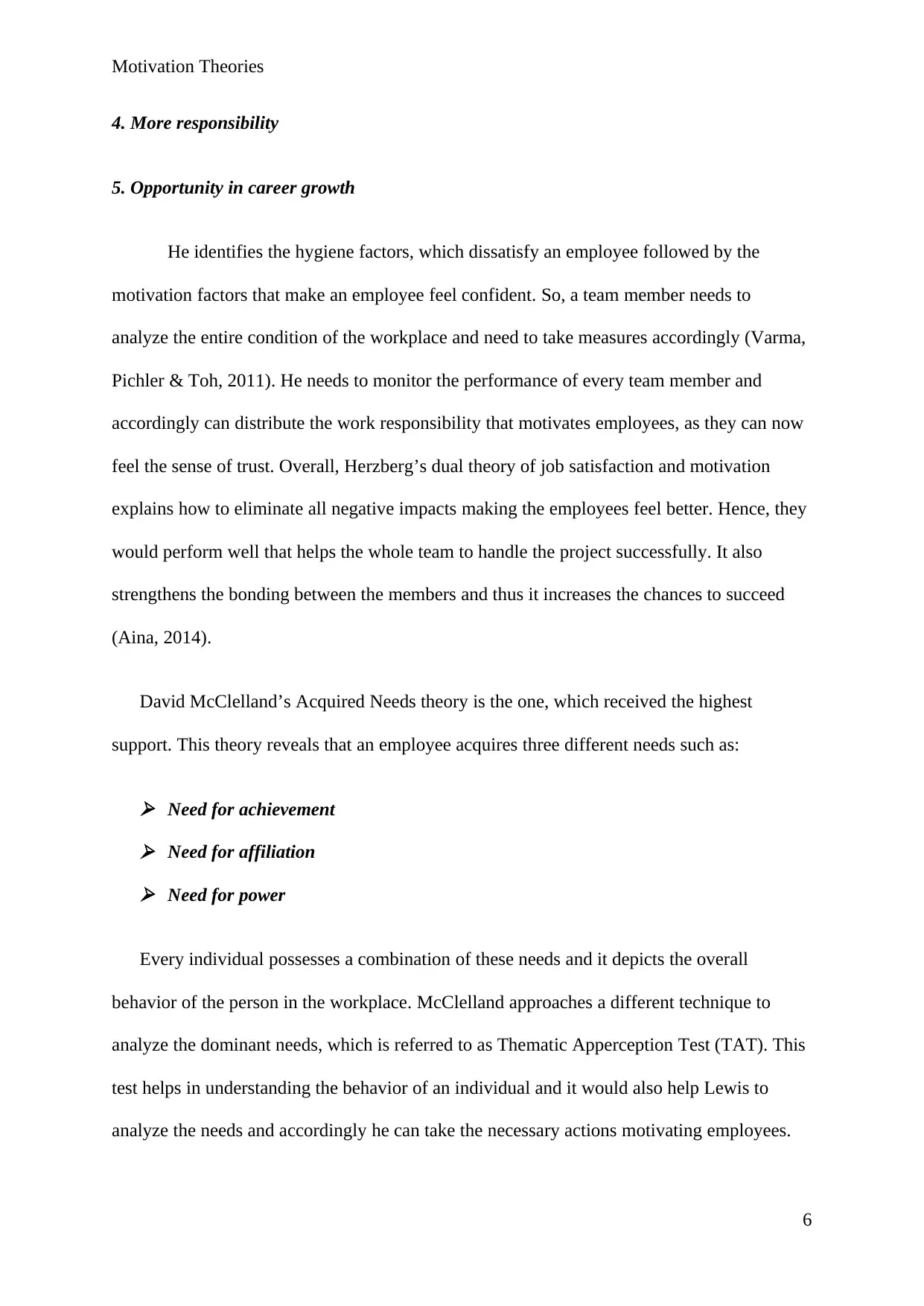
Motivation Theories
4. More responsibility
5. Opportunity in career growth
He identifies the hygiene factors, which dissatisfy an employee followed by the
motivation factors that make an employee feel confident. So, a team member needs to
analyze the entire condition of the workplace and need to take measures accordingly (Varma,
Pichler & Toh, 2011). He needs to monitor the performance of every team member and
accordingly can distribute the work responsibility that motivates employees, as they can now
feel the sense of trust. Overall, Herzberg’s dual theory of job satisfaction and motivation
explains how to eliminate all negative impacts making the employees feel better. Hence, they
would perform well that helps the whole team to handle the project successfully. It also
strengthens the bonding between the members and thus it increases the chances to succeed
(Aina, 2014).
David McClelland’s Acquired Needs theory is the one, which received the highest
support. This theory reveals that an employee acquires three different needs such as:
Need for achievement Need for affiliation Need for power
Every individual possesses a combination of these needs and it depicts the overall
behavior of the person in the workplace. McClelland approaches a different technique to
analyze the dominant needs, which is referred to as Thematic Apperception Test (TAT). This
test helps in understanding the behavior of an individual and it would also help Lewis to
analyze the needs and accordingly he can take the necessary actions motivating employees.
6
4. More responsibility
5. Opportunity in career growth
He identifies the hygiene factors, which dissatisfy an employee followed by the
motivation factors that make an employee feel confident. So, a team member needs to
analyze the entire condition of the workplace and need to take measures accordingly (Varma,
Pichler & Toh, 2011). He needs to monitor the performance of every team member and
accordingly can distribute the work responsibility that motivates employees, as they can now
feel the sense of trust. Overall, Herzberg’s dual theory of job satisfaction and motivation
explains how to eliminate all negative impacts making the employees feel better. Hence, they
would perform well that helps the whole team to handle the project successfully. It also
strengthens the bonding between the members and thus it increases the chances to succeed
(Aina, 2014).
David McClelland’s Acquired Needs theory is the one, which received the highest
support. This theory reveals that an employee acquires three different needs such as:
Need for achievement Need for affiliation Need for power
Every individual possesses a combination of these needs and it depicts the overall
behavior of the person in the workplace. McClelland approaches a different technique to
analyze the dominant needs, which is referred to as Thematic Apperception Test (TAT). This
test helps in understanding the behavior of an individual and it would also help Lewis to
analyze the needs and accordingly he can take the necessary actions motivating employees.
6
Paraphrase This Document
Need a fresh take? Get an instant paraphrase of this document with our AI Paraphraser
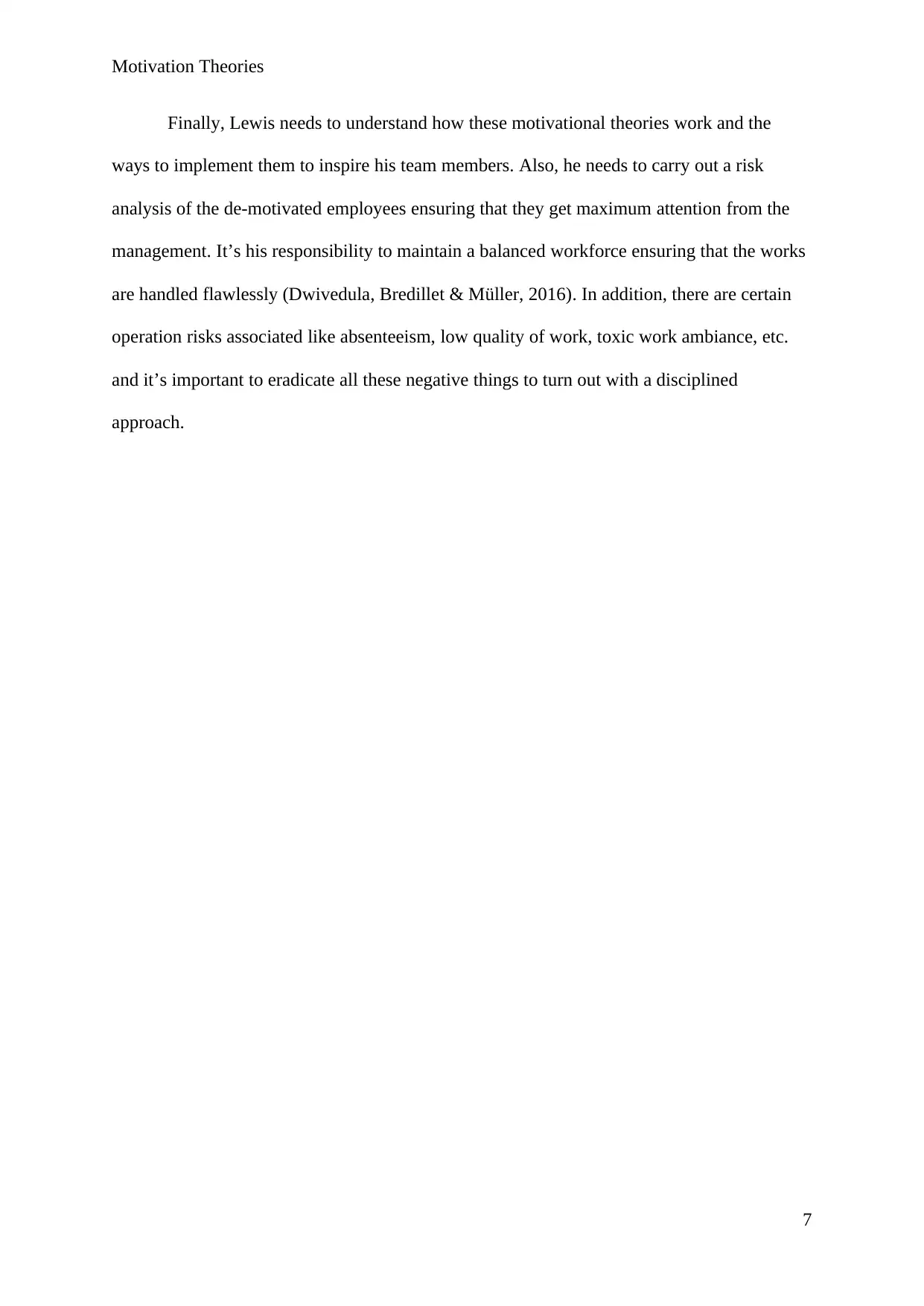
Motivation Theories
Finally, Lewis needs to understand how these motivational theories work and the
ways to implement them to inspire his team members. Also, he needs to carry out a risk
analysis of the de-motivated employees ensuring that they get maximum attention from the
management. It’s his responsibility to maintain a balanced workforce ensuring that the works
are handled flawlessly (Dwivedula, Bredillet & Müller, 2016). In addition, there are certain
operation risks associated like absenteeism, low quality of work, toxic work ambiance, etc.
and it’s important to eradicate all these negative things to turn out with a disciplined
approach.
7
Finally, Lewis needs to understand how these motivational theories work and the
ways to implement them to inspire his team members. Also, he needs to carry out a risk
analysis of the de-motivated employees ensuring that they get maximum attention from the
management. It’s his responsibility to maintain a balanced workforce ensuring that the works
are handled flawlessly (Dwivedula, Bredillet & Müller, 2016). In addition, there are certain
operation risks associated like absenteeism, low quality of work, toxic work ambiance, etc.
and it’s important to eradicate all these negative things to turn out with a disciplined
approach.
7
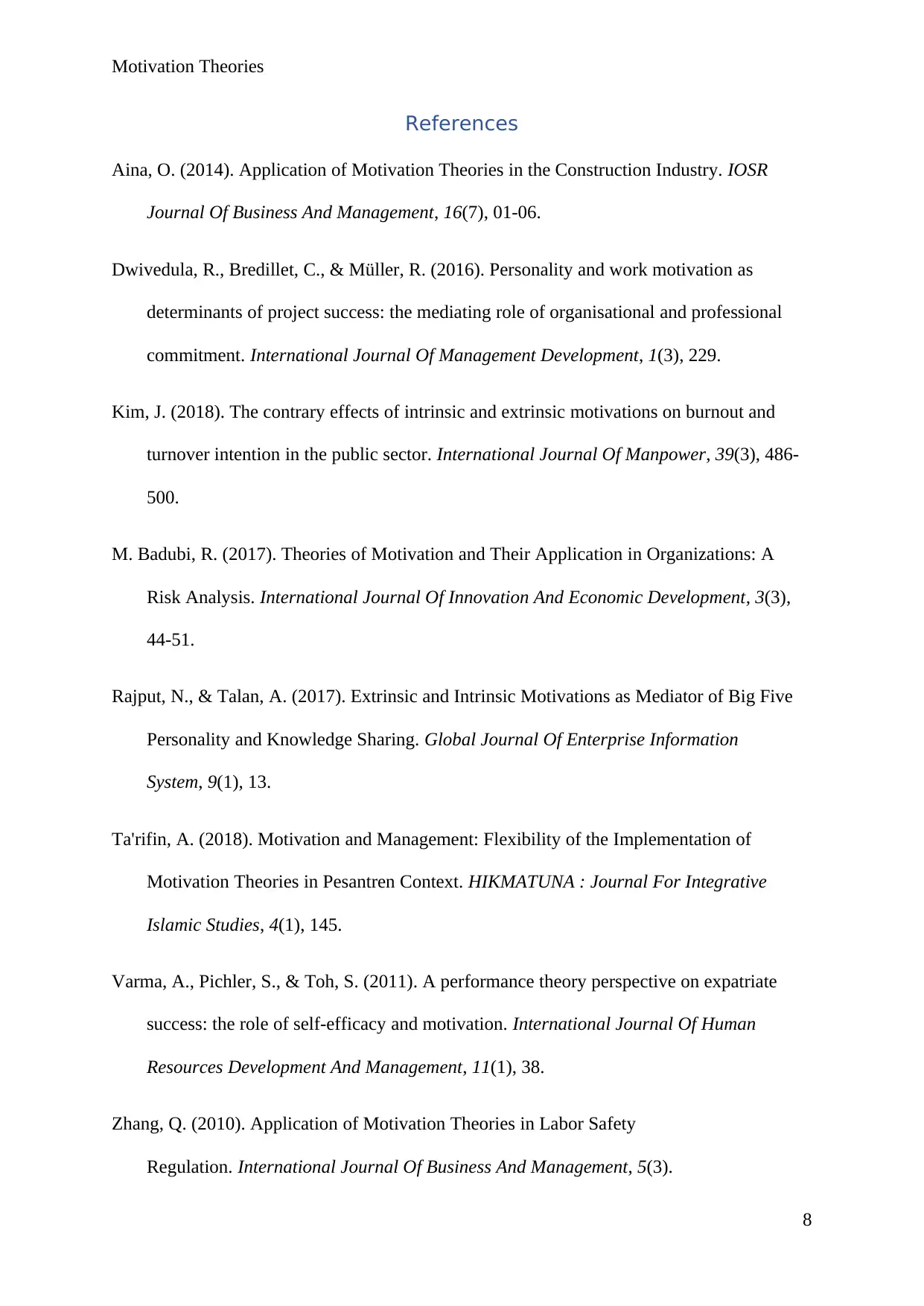
Motivation Theories
References
Aina, O. (2014). Application of Motivation Theories in the Construction Industry. IOSR
Journal Of Business And Management, 16(7), 01-06.
Dwivedula, R., Bredillet, C., & Müller, R. (2016). Personality and work motivation as
determinants of project success: the mediating role of organisational and professional
commitment. International Journal Of Management Development, 1(3), 229.
Kim, J. (2018). The contrary effects of intrinsic and extrinsic motivations on burnout and
turnover intention in the public sector. International Journal Of Manpower, 39(3), 486-
500.
M. Badubi, R. (2017). Theories of Motivation and Their Application in Organizations: A
Risk Analysis. International Journal Of Innovation And Economic Development, 3(3),
44-51.
Rajput, N., & Talan, A. (2017). Extrinsic and Intrinsic Motivations as Mediator of Big Five
Personality and Knowledge Sharing. Global Journal Of Enterprise Information
System, 9(1), 13.
Ta'rifin, A. (2018). Motivation and Management: Flexibility of the Implementation of
Motivation Theories in Pesantren Context. HIKMATUNA : Journal For Integrative
Islamic Studies, 4(1), 145.
Varma, A., Pichler, S., & Toh, S. (2011). A performance theory perspective on expatriate
success: the role of self-efficacy and motivation. International Journal Of Human
Resources Development And Management, 11(1), 38.
Zhang, Q. (2010). Application of Motivation Theories in Labor Safety
Regulation. International Journal Of Business And Management, 5(3).
8
References
Aina, O. (2014). Application of Motivation Theories in the Construction Industry. IOSR
Journal Of Business And Management, 16(7), 01-06.
Dwivedula, R., Bredillet, C., & Müller, R. (2016). Personality and work motivation as
determinants of project success: the mediating role of organisational and professional
commitment. International Journal Of Management Development, 1(3), 229.
Kim, J. (2018). The contrary effects of intrinsic and extrinsic motivations on burnout and
turnover intention in the public sector. International Journal Of Manpower, 39(3), 486-
500.
M. Badubi, R. (2017). Theories of Motivation and Their Application in Organizations: A
Risk Analysis. International Journal Of Innovation And Economic Development, 3(3),
44-51.
Rajput, N., & Talan, A. (2017). Extrinsic and Intrinsic Motivations as Mediator of Big Five
Personality and Knowledge Sharing. Global Journal Of Enterprise Information
System, 9(1), 13.
Ta'rifin, A. (2018). Motivation and Management: Flexibility of the Implementation of
Motivation Theories in Pesantren Context. HIKMATUNA : Journal For Integrative
Islamic Studies, 4(1), 145.
Varma, A., Pichler, S., & Toh, S. (2011). A performance theory perspective on expatriate
success: the role of self-efficacy and motivation. International Journal Of Human
Resources Development And Management, 11(1), 38.
Zhang, Q. (2010). Application of Motivation Theories in Labor Safety
Regulation. International Journal Of Business And Management, 5(3).
8
⊘ This is a preview!⊘
Do you want full access?
Subscribe today to unlock all pages.

Trusted by 1+ million students worldwide
1 out of 9
Related Documents
Your All-in-One AI-Powered Toolkit for Academic Success.
+13062052269
info@desklib.com
Available 24*7 on WhatsApp / Email
![[object Object]](/_next/static/media/star-bottom.7253800d.svg)
Unlock your academic potential
Copyright © 2020–2025 A2Z Services. All Rights Reserved. Developed and managed by ZUCOL.




